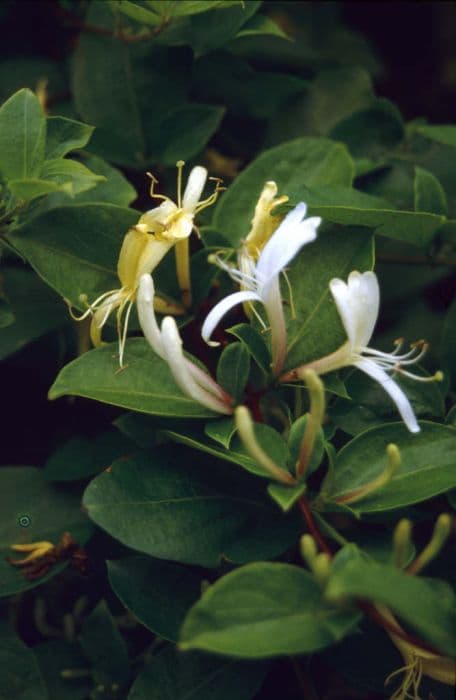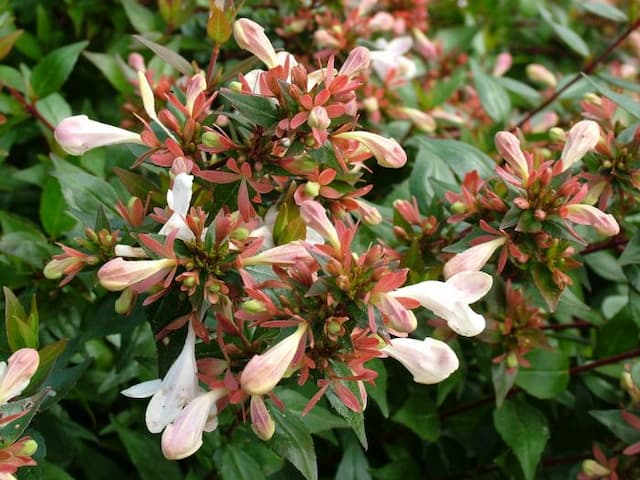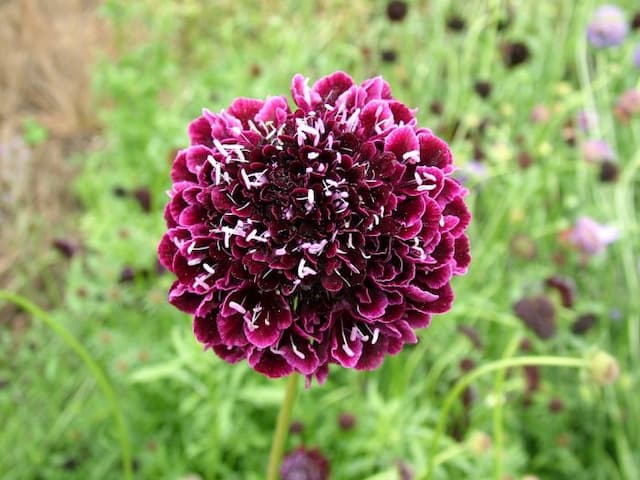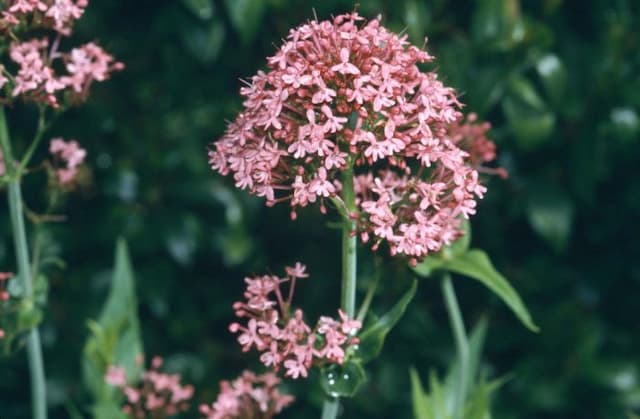Coral Honeysuckle Lonicera sempervirens

ABOUT
The plant known commonly as coral honeysuckle is a sight to behold with its vibrant trumpet-shaped flowers, which boast a fiery red or coral hue on the outside and a softer yellow inside. These blossoms are a magnet for hummingbirds and butterflies, contributing to the plant's dynamic and wildlife-friendly character. The flowers are not only striking in color but are elegantly arranged in whorls at the end of the stems. Foliage on the coral honeysuckle is equally attractive, with leaves that are a deep, blue-green color. These leaves are evergreen in warmer climes, meaning they will provide visual interest throughout the year. The leaves grow opposite each other and tend to be elongated with a smooth texture, adding to the refined appearance of this plant. Adding yet another layer of interest, after the blossoms have put on their show, they are often followed by bright red berries that further entice a variety of birds into the garden. The berries add a touch of bright color against the greenery, creating a picturesque display suitable for any garden aiming for a naturalistic design or a haven for wildlife. As a climbing plant, coral honeysuckle is commonly seen clinging to trellises, fences, or other structures, which it scales with a graceful ease, providing a vertical element in the landscape. Its twining stems weave an intricate pattern as the plant grows, creating a dense curtain of foliage and flowers when in full bloom. This growth habit makes coral honeysuckle an excellent choice for adding height to garden designs without the need for sturdy support. The intertwining stems contribute to the plant's overall lush and robust appearance.
About this plant
 Names
NamesFamily
Caprifoliaceae.
Synonyms
Coral Honeysuckle, Trumpet Honeysuckle, Scarlet Trumpet Honeysuckle, Woodbine.
Common names
Caprifolium sempervirens, Nintooa sempervirens.
 Toxicity
ToxicityTo humans
Coral honeysuckle is not commonly regarded as a toxic plant to humans. However, it is always advisable to exercise caution and avoid ingesting plants that are not generally recognized as food, as individual sensitivities can vary. If someone were to consume parts of this plant, there is a potential for mild upset such as nausea or stomach discomfort. Always consult with a medical professional if ingestion occurs and there is concern about possible poisoning or adverse reactions.
To pets
Coral honeysuckle is not typically known to be toxic to pets. However, individual animals may have different sensitivities, and consumption of non-food plants can sometimes lead to gastrointestinal upset such as vomiting or diarrhea. It is always best to prevent pets from eating ornamental plants. If your pet does consume coral honeysuckle and shows signs of distress, consult your veterinarian.
 Characteristics
CharacteristicsLife cycle
Perennials
Foliage type
Semi-deciduous
Color of leaves
Green
Flower color
Red
Height
3-20 feet (0.91-6.10 meters)
Spread
3-6 feet (0.91-1.83 meters)
Plant type
Climber
Hardiness zones
4-9
Native area
North America
Benefits
 General Benefits
General Benefits- Attracts Wildlife: Lonicera sempervirens, also known as trumpet honeysuckle, is a favorite among hummingbirds, butterflies, and bees, providing nectar and habitat.
- Drought Tolerance: Once established, trumpet honeysuckle can withstand periods of low water availability, making it suitable for xeriscaping.
- Low Maintenance: This plant requires minimal care beyond initial establishment, making it ideal for gardeners looking for low-effort landscaping options.
- Erosion Control: The vining habit and extensive root system help stabilize soil on slopes and prevent erosion.
- Ornamental Value: Trumpet honeysuckle boasts attractive, trumpet-shaped flowers and can add a splash of color to fences, trellises, and arbors in landscapes.
- Natural Privacy Screen: When grown on structures, this vine can create a natural privacy screen, blocking unwanted views and providing shade.
- Long Blooming Period: The plant offers a long season of blooms, often from spring to summer, providing long-term visual interest in the garden.
- Native Habitat Support: Being native to the eastern United States, it supports local ecosystems and is well-adapted to the regional climate and soil conditions.
- Deer Resistance: Trumpet honeysuckle is generally resistant to deer, which can make it a good choice for gardens in areas with high deer populations.
- Winter Interest: Even when not in bloom, the semi-evergreen foliage and red berries of trumpet honeysuckle can provide visual interest during the winter months.
 Medical Properties
Medical Properties- Antibacterial: Lonicera sempervirens, commonly known as coral honeysuckle, has been studied for its potential antibacterial activity.
- Anti-inflammatory: The plant may have components that help reduce inflammation, although this use is not well established.
 Air-purifying Qualities
Air-purifying QualitiesThis plant is not specifically known for air purifying qualities.
 Other Uses
Other Uses- Lonicera sempervirens, also known as coral honeysuckle, can be used as a natural dye for fabrics, yielding shades from pale yellow to deep orange depending on the mordant used.
- The woody vines of coral honeysuckle can be creatively woven into small baskets or decorative items by skilled artisans.
- As a climbing plant, coral honeysuckle can be trained over arbors or pergolas to create natural, living architectural details.
- The long, tubular flowers of the coral honeysuckle can be used as impromptu water troughs for hummingbirds when positioned horizontally.
- When dried, the sweetly scented flowers can be incorporated into homemade potpourris.
- The flexible stems of young coral honeysuckle plants can be shaped into live plant sculptures or topiaries with patience and careful pruning.
- Coral honeysuckle can be used in educational settings as a tool to teach about the value of native plants in supporting local wildlife and ecosystems.
- The plant's aggressive growth can be harnessed for erosion control in steep or challenging landscaping areas.
- During winter, coral honeysuckle's red berries provide a source of natural, festive decoration in the garden when few other plants bear fruit.
- Its dense foliage offers privacy screening when grown along fences or trellises.
Interesting Facts
 Feng Shui
Feng ShuiThe Trumpet Honeysuckle is not used in Feng Shui practice.
 Zodiac Sign Compitability
Zodiac Sign CompitabilityThe Trumpet Honeysuckle is not used in astrology practice.
 Plant Symbolism
Plant Symbolism- Devoted affection: The Lonicera sempervirens, commonly known as Coral Honeysuckle, often represents devoted affection, owing to its entwining growing habit that suggests clinging and steadfast support, similar to the nature of human emotions.
- Fraternal love: Giving someone Coral Honeysuckle could symbolize a brotherly or sisterly love, indicating a non-romantic yet deep, familial bond.
- Generosity: With its abundant blossoms that provide nectar for hummingbirds and insects, Coral Honeysuckle suggests the idea of generosity and giving without expecting a return.
- Happiness: The bright blooms and sweet fragrance of Coral Honeysuckle can be symbols of happiness and joy, typically bringing a positive vibe to gardens and spaces.
- Long-lasting bonds: As a perennial plant, the Coral Honeysuckle can live for many years, often symbolizing long-lasting relationships and enduring connections.
 Water
WaterThe Trumpet Honeysuckle (Lonicera sempervirens) should be watered deeply but infrequently, allowing the soil to dry out slightly between watering. Water the plant with approximately 1 gallon of water every 7 to 10 days during the growing season. In cooler months or when the plant is dormant, reduce watering to every 2 to 3 weeks depending on the moisture level of the soil. Overwatering or poor drainage can lead to root rot, so ensure the soil is well-draining. Adjust the watering schedule based on rainfall and temperature, giving more water during hot, dry periods and less during cool, wet periods.
 Light
LightThe Trumpet Honeysuckle thrives best in full sun to partial shade. It should be placed in a location where it can receive at least 6 hours of direct sunlight per day. Although it can tolerate some shade, the plant will produce the most flowers when it is grown in full sun.
 Temperature
TemperatureTrumpet Honeysuckle flourishes in temperatures between 60°F and 90°F. It can withstand minimum temperatures down to about -20°F. The ideal growing conditions for this plant lie within the USDA hardiness zones 4 through 9, where it can tolerate the seasonal temperature variations.
 Pruning
PruningPrune the Trumpet Honeysuckle immediately after flowering to shape the plant and promote vigorous growth. Pruning can be done annually, but it's not strictly necessary every year unless you wish to control the size or remove dead and damaged branches. The best time to prune is late winter or early spring, before new growth begins.
 Cleaning
CleaningAs needed
 Soil
SoilThe best soil mix for Coral Honeysuckle is well-draining soil with organic matter and loam. A pH between 6.0 and 8.0 suits this plant well.
 Repotting
RepottingCoral Honeysuckle rarely needs repotting as it's typically grown outdoors; if containerized, repot every 3 to 5 years.
 Humidity & Misting
Humidity & MistingCoral Honeysuckle is tolerant of a wide range of humidity levels, not requiring any specific humidity conditions.
 Suitable locations
Suitable locationsIndoor
Provide bright light, allow for climbing, water regularly.
Outdoor
Full sun to part shade, trellis or support for climbing.
Hardiness zone
4-9 USDA
 Life cycle
Life cycleLonicera sempervirens, commonly known as the coral honeysuckle, begins its life cycle when seeds germinate in the spring after a period of cold stratification. The seedlings emerge and grow into young plants, developing a root system and foliage. As the coral honeysuckle matures, it develops twining vines that climb by wrapping around structures or other plants. During late spring to summer, the plant enters its flowering stage, producing clusters of trumpet-shaped, red to orange flowers that are attractive to hummingbirds and butterflies. After pollination, typically by hummingbirds, the plant produces small, red to black berries, which are then dispersed by birds who eat them. The coral honeysuckle is a perennial plant, which means it can live for many years, going through cycles of growth, flowering, and dormancy typically in the winter months.
 Propogation
PropogationPropogation time
Spring-Early Summer
The coral honeysuckle (Lonicera sempervirens) is best propagated using semi-hardwood cuttings taken in late summer. To do this, select a healthy stem that is not flowering and cut a 4 to 6 inch (10 to 15 cm) section just below a leaf node. The lower leaves should be removed, and the cut end may be dipped in rooting hormone to encourage root development. The cutting should then be inserted into a pot filled with a well-draining potting mix. To maintain humidity, a plastic bag can be placed over the pot, being cautious to keep the plastic from touching the leaves. The cutting should be kept in indirect sunlight and the soil should be kept consistently moist. Roots typically develop in 1 to 2 months, after which the new coral honeysuckle plant can be transferred to a larger pot or planted directly in the garden.
![Weigela [Monet]](/_next/image?url=https%3A%2F%2Fplants-admin.emdemapps.com%2Fimages%2Fplants%2F%2Fimages%2F604b6243e9bcd.png&w=640&q=75)








